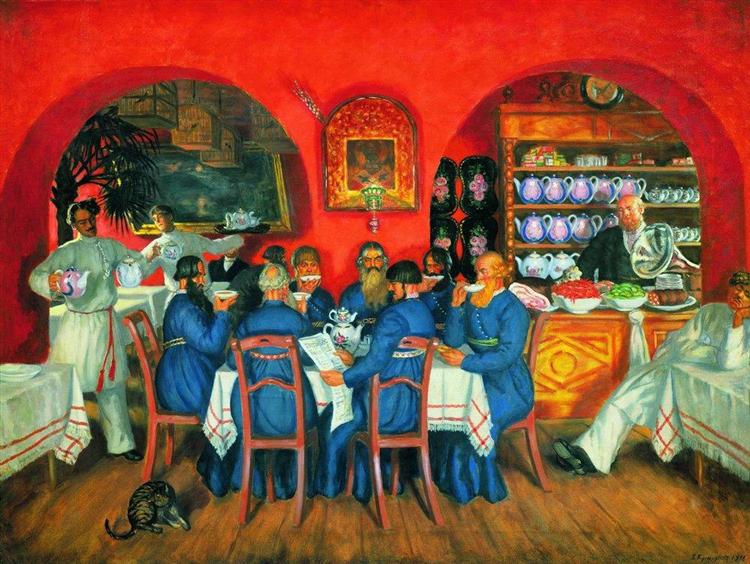Kustodiev – “Moscow tavern”
Kustodiev’s mature style was clearly manifested in his 1916 painting “Moscow Tavern”. It is known that the love of tea drinking has long been among the characteristic signs of Moscow life. Back in 1848, in one of his essays on Moscow life, Ivan Kokorev wrote: “Whoever knows Moscow firsthand, not by a cursory glance, will agree that tea is the fifth element of its inhabitants and that, if it were not for this earthly ambition, Muscovites had would be a radical revolution. ” Kustodiev was attracted by the opportunity to present to the audience a picture of one of the varieties of the Moscow tradition. While in Moscow, the artist carefully looked at the atmosphere of the tavern, where in cold weather, according to the prevailing custom, reckless cabbies, Old Believers, who observed a leisurely, decorous ritual of tea drinking, came to rest and drink tea. The image created by Kustodiev is the fruit of a combination of life observations and a wealth of fantasy, on the basis of which there is a “growth” or “thickening” of the qualities of nature. The artist strove for a sharp characteristic in the interpretation of the interior, types, costumes, in the transfer of people’s behavior. This is one of the main tasks and, at the same time, the difficulties in his work, so that with all the deliberate “structure”, conventionality of the depicted, the viewer has a feeling of the complete reliability of the picture, the indissolubility of life and artistic truth.
Kustodiev put red as the basis of the color system of the canvas, in order to conditionally convey the atmosphere of the heat of tavern tea drinking and at the same time evoke associations when depicting folk types of faces with red-background Novgorod icons. In the foreground, as on the stage of a theater, the artist presented under the icon of Nicholas the saint a circle of reckless men of different ages in their typical blue army jackets, belted with colored sashes. They earnestly sip tea from saucers, and the youngest of them, literate, reads the Russian word – the most popular and “for the people” Moscow newspaper of the Sytinsk publishing house.
Behind the symmetrically located arched vaults, as if behind the side curtains, two more interiors are contrastingly juxtaposed – a cramped room filled with painted teapots and hung with fancy trays with snacks on the counter and the all-seeing innkeeper at the gramophone and a room for selected visitors with “romantic taste.” Tavern romance is a palm tree in a tub, a lunar sea landscape on the wall, songbirds in cages. The running of the agile sexual Yaroslavl people emphasizes the pose of their comrade, dozing to the right at the table from temporary idleness, contrasts with the unhurried movements of those drinking tea.
Creating a fusion of a high professional culture of painting with the traditions of popular print, understood in the broadest sense as a pictorial folklore beginning, Kustodiev at the same time brought easel painting closer to elements of theatrical in order to achieve a spectacular image, its meaningful “density”, concentration. New in his art was the emerging tendency to use the techniques of the academic heritage, above all symmetry, balance of composition. His painting clearly reveals a whole layer of Moscow, and through it – of Russian traditional life.
Year of painting: 1916.
Dimensions of the painting: 99.3 x 129.3 cm.
Material: canvas.
Writing technique: oil.
Genre: genre painting.
Style: modern.
Gallery: State Tretyakov Gallery, Moscow, Russia.
